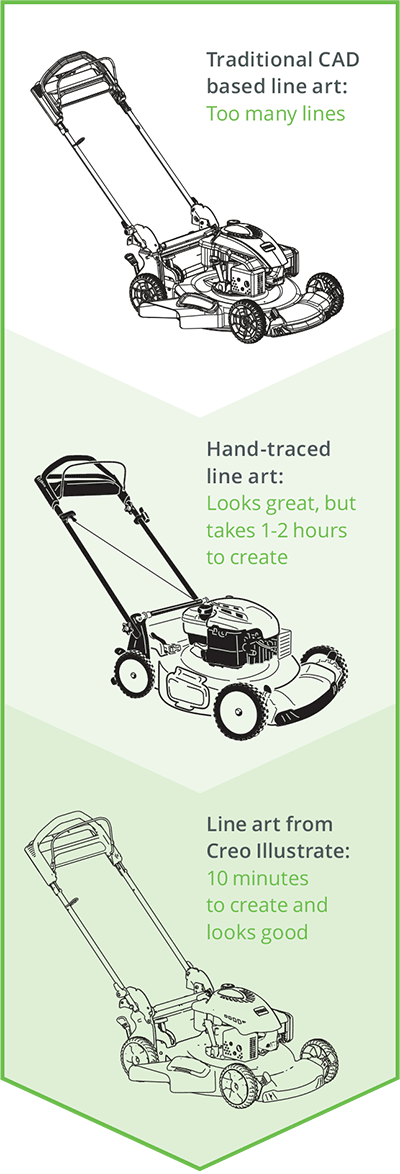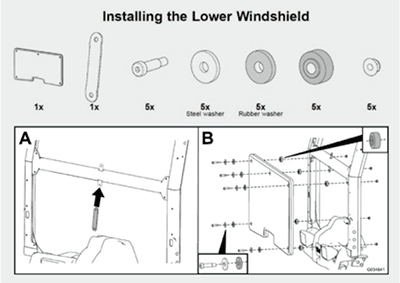Toro Uses Creo Illustrate to Increase Illustrator Efficiency, End-User Comprehension
How The Toro Company took their service efficiency to new heights by creating more accurate technical illustrations in less time, with an eye toward service, engineering, and their end-users.
Having incorporated publishing and content management system solutions from PTC successfully and looking to help their technical illustrations tell a more complete story, as well as to make their content authors more efficient, Toro knew they needed one additional tool. By adding PTC’s Creo Illustrate to their arsenal, Toro was able to take their line art drawings to the next level with CAD integration and storyboards, in a fraction of the time.
Creating technical documentation for complex equipment has to cater to the needs of the equipment operators or end-users, service technicians maintaining or repairing the equipment, as well as technicians and others coming into contact with parts catalogs for the equipment. Toro’s technical content authors had to create a final illustrated product that satisfied the needs of all these stakeholders, or risk end-users not being able to perform self-service on their equipment, technicians not understanding repair instructions, and inaccurate parts catalogs leading to delays in service and repair.
Toro’s highly skilled content authors were able to produce excellent line art illustrations, but because they could not use the engineering content efficiently, or manipulate it effectively, excessive time was spent creating technical illustrations. That’s when Brian York, Principle Systems Specialist and Andy Pieper, Information Architect at Toro, knew that in order to keep up, scale, and innovate for their technicians and end-users, Toro needed a new tool that their authors could leverage, would amplify their skills, and make them more efficient.
Toro’s Hundred-Year Legacy Looks Forward
From their humble origins in 1914, The Toro Company has become a leading worldwide provider of innovative solutions for the outdoor environment including turf, snow, ground-engaging equipment, irrigation, and outdoor lighting solutions. Toro offers a wide range of products that help golf courses, professional contractors, groundskeepers, agricultural growers, rental companies, government and educational institutions, and homeowners – in addition to many leading sports venues and historic sites around the world. As manufacturers of outdoor power equipment and services for the creation and maintenance of landscapes, their business is 72% professional and 27% residential. Toro employs more than 6,800 people worldwide, including 1,000 at headquarters in Bloomington, Minnesota.
Technically Correct
With its history of success and its skilled illustrators, why did Toro choose to elevate their technical illustrations? “Our content authors were hand-tracing the perimeter of each equipment piece, and would have to hand-draw line art based on a 2d CAD model or even a photograph. We wanted to give them the best tools for the job,” says York.
Historically, Toro’s authors would use the CAD model and tracing to produce an illustration, a process that worked well, albeit slowly. But when it came to 3D CAD data, the authors could not get the geometry as efficiently. The line art directly from Creo had too many lines, while hand-traced line art looked polished but took hours to create. “As our company’s products and reach expanded, we needed to help our authors keep up without sacrificing quality for our customers or end-users,” says York.
Luck of The Draw
As longtime PTC clients, Toro sought tools within the family of solutions they were already so familiar with. “Toro wanted to help their authors and in turn, their documentation and manuals, tell a story with every picture. Creo Illustrate was a natural and intuitive choice,” says Jeff Coon, PTC’s Solution Management Director and resident expert on all things illustration. “We knew we could save Toro’s content authors time in creating highly detailed drawings, but we also knew there were additional opportunities.”
Because the content authors were able to use engineering content more effectively, their drawings would be produced faster, and there would be less time to a final product. The transition to Creo Illustrate turned out to be a perfect fit.
RETURNS ON INVESTMENT: INVESTING RETURNS
The time saved by using Creo Illustrate was significant. Toro’s team of authors were able to reduce the time it took to create an illustration from an average of one hour down to only 15 minutes. “We weren’t looking to produce faster just for the sake of saving time or money, we wanted to reinvest our authors’ time into other projects, like incorporating more interactive 3D content into our manuals.” says York.
Now content authors have direct connection with CAD data from engineering to create illustrations, sequences and animations that effectively communicate technical information and ensure that graphics are accurate and continually updated when changes are made. An ancillary advantage here is the ability to pre-empt any quality issues in production of Toro equipment, because those same CAD models are even more detailed and accurate.

Creo Illustrate reduced the time to create an illustration from an average of 1 hour to 15 minutes.
Jeff Coon, PTC’s Solution Management Director
“Creo Illustrate didn’t require a lot of training and our authors were already familiar with the interface,” adds Pieper. Using CAD data to populate illustrations saved a tremendous amount of time, which was then invested in Toro’s forward-looking vision for its technical documentation and user manuals.
A PICTURE TELLS A THOUSAND WORDS
“If CAD data is not of great quality, all of its derivatives can suffer. It used to be that the technical publication department would use whatever was available, but as their abilities grew, they expected a better original CAD drawing,” says Coon. And, with authors being able to pull directly from the latest CAD data, they did not need to take up the time of an engineer who had to explain functionality. More than that, Creo Illustrate closed the loop between engineering and the technical illustrators, whereby the authors could convey instructions for maintenance or repair through complete pictures instead of graphics and heavy text.
Before Creo Illustrate, instructions were provided in a single image, or with a reliance on lengthy supporting text that accompanied each image. Because they were now able to create illustrations much faster and much more accurately, Toro was able to eliminate much of the text in its technical publications, and incorporate storyboards, which showed step-by-step instructions. Toro reduced some instructions from eight pages to a single page, while improving the way they convey information. As a global company, Toro’s translation costs were also reduced, as they now needed to translate much less text in their publications.

Andy Pieper Information Architect, Toro
